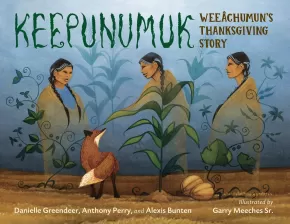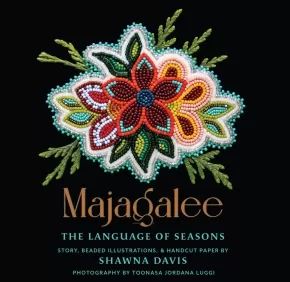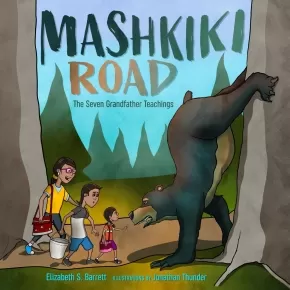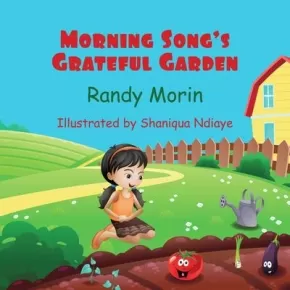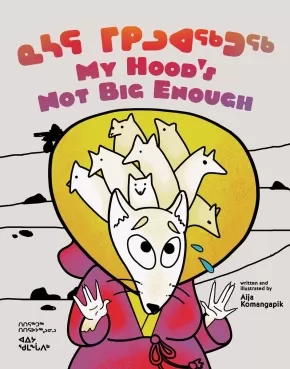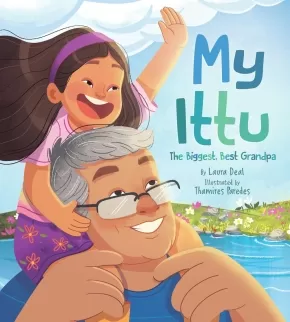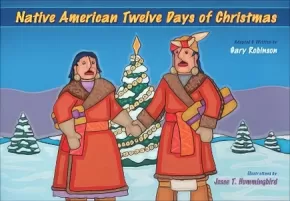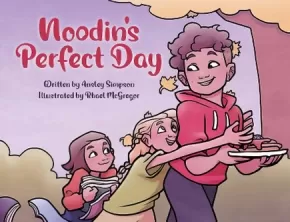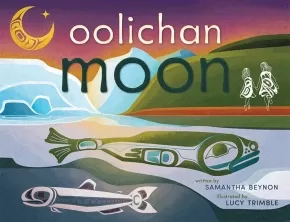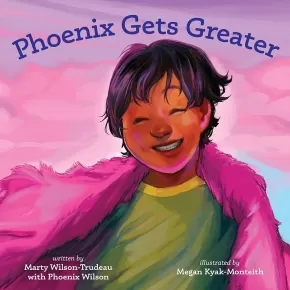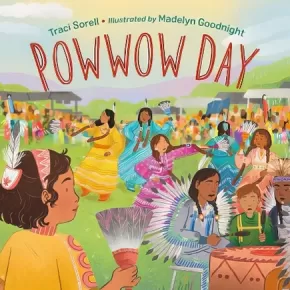
Indigenous
226
-
240
of
372 Results;
Sort By
Go To
of 25
Keepunumuk: Weeachumun's Thanksgiving Story
$21.99
Artists:
Format:
Hardcover
Text Content Territories:
Indigenous American; Native American; Wampanoag (Wôpanâak); Mashpee Wampanoag Tribe;
ISBN / Barcode: 9781623542900
Synopsis:
Synopsis:
In this Wampanoag story told in a Native tradition, two kids from the Mashpee Wampanoag tribe learn the story of Weeâchumun (corn) and the first Thanksgiving.
The Thanksgiving story that most Americans know celebrates the Pilgrims. But without members of the Wampanoag tribe who already lived on the land where the Pilgrims settled, the Pilgrims would never have made it through their first winter. And without Weeâchumun (corn), the Native people wouldn't have helped.
An important picture book honoring both the history and tradition that surrounds the story of the first Thanksgiving.
Reviews
"A Wamponoag grandmother plants her garden with weeâchumun (corn), beans, and squash, or the Three Sisters. When her grandchildren ask to hear the story of Thanksgiving, N8hkumuhs tells them that their people call it Keepunumuk, “the time of harvest,” and explains what really happened. The tale opens with Seagull warning Weeâchumun—depicted as a woman with a translucent body—of the Pilgrims’ arrival; Weeâchumun worries because many of the First Peoples who cared for her have gone to the Spirit World, and she fears this will be her last winter. Fox keeps an eye out and in spring tells Weeâchumun and her sisters that the newcomers endured a hard winter; many died. Weeâchumun and her sisters want to help: “We will send the First Peoples to help the newcomers.” The Wampanoag people teach the survivors how to plant corn, beans, and squash. The settlers hold a feast to celebrate the harvest; though it’s remembered by many as the first Thanksgiving, backmatter explains that because of the disease and warfare brought by the settlers, for the Wampanoag people, it is remembered as a day of mourning. Rich, saturated acrylics imbued with a touch of magic add to the vibrancy of this important, beautiful story. A much-needed Thanksgiving retelling that centers the Wamponoag people. (glossary, information on the Wampanoag map, recipes) (Picture book. 3-7)" —Kirkus, starred review
"This picture book features a contemporary Wampanoag grandmother and her grandchildren. N8hkumuhs shares the story of the Three Sisters—Corn, Beans, and Squash—and the first Thanksgiving, known as “Keepunumuk” by the Wampanoag people. The book transitions into a combination of history and storytelling about contact between the “First Peoples” and the newcomers. This format will be novel to some young children given the setting and timeframe of the story, though the book attempts to differentiate the parts that are the story by changing the typeface and including ethereal-like images of the Three Sisters. “Before You Begin” and “Important Words to Know” sections also provide context. Rich back matter includes more information about the Wampanoag tribes, a traditional recipe, and a photo and information about the real Maple and Quill, the grandchildren in the story. Overall, this story is a good addition for the historical knowledge of the first Thanksgiving from the Wampanoag viewpoint. VERDICT: A good choice for libraries striving to share Indigenous perspectives."— School Library Journal
Additional Information
32 pages | 11.38" x 8.81" | Hardcover
Majagalee: The Language of Seasons
$22.00
Artists:
Format:
Hardcover
Text Content Territories:
Indigenous Canadian; First Nations; Gitxsan (Gitksan);
ISBN / Barcode: 9781990458002
Synopsis:
Synopsis:
Shawna Davis invites the reader to explore each of the four seasons through her beautiful words and lush, unforgettable, beaded illustrations.
We begin in Gwooyim (Spring) when the Majagalee, the Sim Algyax word for “flower,” are just beginning to sprout. We then move on to Sint (Summer) when Grandmother Sun stays in the sky a bit longer. Next there is Xwsit (Fall), just as Summer begins to get sleepy, and Maadim (Winter) where the snow has fallen and the freezer is full.
This is a story of nature, its importance to our lives, and why it must be cared for and respected.
Toonasa Jordana Luggi’s lovely, rich, and nearly tactile photographs are the perfect complement to Shawna’s hand-beaded artwork and wonderful, hand-cut paper backgrounds.
Includes Pronunciation Guides.
Reviews
“...simple, evocative poetry is culturally specific, rooted in a deep love of the land and the people around her but it’s also relatable to readers of different backgrounds. The lyrical verse in Majagalee makes it an ideal read-aloud book.... Majagalee is an elevated concept book. It introduces readers to the seasons, the plants and animals of the Northwest Coast, Sim Algyax, Indigenous art, and the importance of all these things to Gitksan culture. Despite its apparent simplicity, Majagalee is a complex and brilliantly constructed book. It will appeal to Indigenous and non-Indigenous readers alike, and for teachers and parents, it serves as an outstanding example of a book that demonstrates the ongoing presence and beauty of Indigenous cultures in what is now known as Canada..” – Quill & Quire, starred review
Educator Information
Juvenile Fiction. This picture book explores the four seasons on the northwest coast of what is currently British Columbia from a Gitksan perspective.
Additional information
Pages: 40
Mashkiki Road: The Seven Grandfather Teachings
$25.00
Format:
Hardcover
Text Content Territories:
Indigenous American; Native American; Anishinaabeg; Ojibwe (Chippewa); Red Lake Nation;
ISBN / Barcode: 9781681342382
Synopsis:
Synopsis:
Three young cousins explore the woods in search of medicines that heal and purify, also gathering advice from wise beings who offer life lessons cherished through generations.
“I’m running low on medicines,” says Grandma Mindy. At once, Lily, Ogimaa, and Ellie are ready to help. Together they will travel Mashkiki Road—the road where the medicines grow—in search of sage and cedar for Grandma.
Not too far into the woods, they encounter Makwa (Bear), who introduces them to the Seven Grandfather Teachings. Makwa advises them to have the courage to do what is right. Farther along the path they meet Sa’be (Bigfoot), who represents honesty, and Mashkode-Bizhiikii (Buffalo), who encourages respect. When the cousins reach a grove of sage plants, they know what to do. They put out tobacco, give thanks, and gather just the amount Grandma needs—no more, no less.
As they continue on Mashkiki Road, they meet Ma’iingan (Wolf), Amik (Beaver), and Mikinaak (Turtle), who each offer their own lessons. At the cedar grove, the children put out tobacco, give thanks, and gather what they need. As they head home at last, Migizi (Eagle) glides by to assure them he has been watching over their journey. Migizi offers the seventh Grandfather Teaching: love.
Back at Grandma’s, Lily, Ogimaa, and Ellie have much treasure to share: cedar and sage from Mashkiki Road, and also tales of the wisdom they gained along the way.
Reviews
"Native teachings are at the center of this beautiful children's picture book by two members of the Red Lake Ojibwe.... Their partnership is a winner. Barrett’s lyrical text is perfectly complemented by Thunder’s contemporary illustrations."- St. Paul Pioneer Press
Educator Information
Recommended for ages 3 to 7.
Includes a Glossary of Ojibwe words used in the story.
Additional Information
32 pages | 10.00" x 10.00" | Hardcover
Morning Song’s Grateful Garden (2 in stock, in reprint)
$16.95
Artists:
Format:
Paperback
Text Content Territories:
Indigenous Canadian; First Nations; Cree (Nehiyawak);
ISBN / Barcode: 9781772311822
Synopsis:
Synopsis:
Morning Song is a Cree girl who lives on a reserve. She does not like to eat vegetables because she thinks they are not important and do not taste good. One day, she goes on a walk and stumbles upon a magic garden where vegetables can talk. Morning Song meets carrots, cabbage, cucumbers, potatoes, pumpkins and other vegetables which explain her why each of them is an important part of a healthy diet. The book teaches children about the importance of eating healthy and living a happy and active lifestyle.
Educator Information
Recommended for ages 4 to 8.
Additional Information
26 pages | 8.00" x 8.00" | Paperback
My Hood's Not Big Enough! (English/Inuktitut)
$20.95
Artists:
Format:
Hardcover
Text Content Territories:
Indigenous Canadian; Inuit;
Grade Levels: Preschool; Kindergarten;
ISBN / Barcode: 9781774505472
Synopsis:
Synopsis:
"Oof! My hood is not big enough!" said Mother Fox. Who will help her?
Mother Fox loves all her babies so much. But when she tries to carry all eight of her babies on her back, her hood's not big enough! What will she do? See how her family offers to help as Mother Fox learns she does not need to carry all her babies alone.
Snuggle up and enjoy a sweet story about motherhood and family in this sweet bilingual picture book.
Educator & Series Information
Recommended for ages 3 - 5.
This is an Arvaaq Book. Books in this series are intended for infants and very young children and are designed to help children develop physical, social, emotional, cognitive, and language skills.
Includes activities for parents and teachers in a Let's Talk section.
Additional Information
24 pages | 11.00" x 14.00" | Hardcover
My Ittu: The Biggest, Best Grandpa
$18.95
Artists:
Format:
Hardcover
Text Content Territories:
Indigenous Canadian; Inuit;
Grade Levels: Preschool; Kindergarten;
ISBN / Barcode: 9781772274417
Synopsis:
Synopsis:
Maniq loves her ittu (short for ittupajaaq, an Inuktitut word for grandfather). He’s brave—enough to wrestle the grumpiest polar bear, if he ever needed to! He’s tall—enough to see over the tallest mountain tops. He’s generous—enough to walk through a blizzard to make sure others have delicious food to eat. And above all, he loves his grandkids, every single one of them—and there must be close to one hundred, by Maniq’s count at least!
Educator Information
Recommended for ages 3 to 5.
Additional Information
28 pages | 9.50" x 8.50" | Hardcover
Native American Twelve Days of Christmas
$18.95
Artists:
Format:
Hardcover
Text Content Territories:
Indigenous American; Native American;
ISBN / Barcode: 9781939053459
Synopsis:
Synopsis:
The beloved traditional English Christmas carol, The Twelve Days of Christmas, has been adapted here to reflect aspects of the richly varied cultures and traditions of twelve Native American cultural groups from different parts of the U.S. A cultural background is included for each day's gift in an easy-to-understand manner, placing the adapted song lyrics in the context of these tribal cultures.
Educator Information
Recommended for grades 1 to 5.
Additional Information
32 pages | 8.25" x 11.75"
nimosôm anima--nimihšōmihš ta-minciwēnciman: Grandfather's Reminder
$19.95
Artists:
Format:
Hardcover
Text Content Territories:
Indigenous Canadian; First Nations; Anishinaabeg; Ojibway; Saulteaux; Cree (Nehiyawak); Plains Cree;
Grade Levels: Kindergarten; 1;
ISBN / Barcode: 9781988783826
Synopsis:
Synopsis:
“We need to be careful that we don’t hurt the gifts that are given to us.” Told in Plains Cree, Saulteaux, and English, this simple tale of traditional teachings and values follows a grandparent and grandchild on a visit to a chokecherry patch, where lessons about respect and gratitude for the earth’s gifts are shared.
Educator Information
Recommended for ages 3+
Triple-language format: Plains Cree, Saulteaux, and English.
An afterword includes a Saulteaux and Plains Cree pronunciation guide.
Additional Information
40 pages | 11.00" x 8.50" | Hardcover
Noodin's Perfect Day
$18.95
Artists:
Format:
Paperback
Text Content Territories:
Indigenous Canadian;
ISBN / Barcode: 9781999156251
Synopsis:
Synopsis:
Noodin had their perfect day planned - until surprise babysitting interrupts their plans and sends them on an urban adventure!
When Noodin's perfect day is interrupted, they decide to strike out for adventure instead - spending the day with their human, animal, and tree cousins in the city. But will Noodin ever get the pancakes they're craving? Come along and find out!
Educator Information
Recommended for ages 3 to 5.
Noodin is a nonbinary urban Indigenous kid.
Themes: Urban Indigenous, Modern Family, Cousins, Babysitting, Adventure, Divorced Parents
Additional Information
28 pages | 10.75" x 8.25" | Paperback
Oolichan Moon
$24.95
Artists:
Format:
Hardcover
Text Content Territories:
Indigenous Canadian; First Nations; Nisga'a;
ISBN / Barcode: 9781550179927
Synopsis:
Synopsis:
Oolichan Moon is a beautifully illustrated children’s book about passing down traditional knowledge from Nisga'a Elders and the sacredness of traditional foods, particularly the oolichan fish.
Together, author Samantha Beynon and illustrator Lucy Trimble have created a children’s book rich with cultural knowledge and tradition that relates to their Nisga'a ancestry surrounding the oolichan fish.
With playful text and vibrant illustrations, young readers can learn alongside the two Nisga'a sisters as they are gifted with sacred knowledge from their Elders, passed down for many generations in the oral tradition.
A gorgeous celebration of Nisga'a language, history and culture, Oolichan Moon also includes historical and cultural information about the oolichan fish and related Nisga'a vocabulary.
Awards
- 2023 Indigenous Voices Awards Winner: Published Graphic Novels, Comics and Illustrated Books
Reviews
"Oolichan Moon is a wonderful story with such simple teachings for all of us. The oolichan were so important for many people of the rivers. The long winter is over, and Spring is here and so too the oolichans return to feed and provide for the people. Today, we still fish for the Oolichan but like most fish of the river their numbers are low. This story teaches all of us that we must only take what is needed and that we should always give something back. This is survival. This is the teaching." — Joseph Dandurand, storyteller and author of A Magical Sturgeon and The Sasquatch, the Fire
"Samantha Beynon and Lucy Trimble have created a beautiful, heart-warming story featuring a nutritious and iconic little fish of the Northwest Coast. Since time immemorial, oulachens have served as a food and esteemed condiment for the Nisga’a Peoples of the Nass Valley and for many other coastal First Nations from Alaska to the Columbia River. Through the delightful teachings of wise and kind grandparents, the granddaughters—and we, as readers—are able to learn about oulachens and their immense cultural value. We learn how and when they are caught, and how they are prepared, and especially how they are rendered into a nutrient-rich and highly valued oil. At the same time, we experience “history, laughter, and love,” and gain insights into the deep and lasting relationships that Indigenous Peoples have developed with the fish and other species of their homelands and how children and youth are taught about these profound connections. The illustrations are stunning." — Nancy Turner, Professor Emeritus, University of Victoria, and author of Plants of Haida Gwaii
“I had a little tear welling up in my eye as I thought how cool it will be for kids to be reading about part of their culture. This kind of story is long overdue and badly needed. I hope it is the first of many.” — Edward Desson, fisheries manager, Nisga’a Fisheries and Wildlife, Nisga’a Lisims Government
"Packed with traditional knowledge, family values and deep wisdom, this story instantly transports you to a timeless place! Like visiting with family, you can feel strength and warmth beaming from each page." — Lucky Budd, author of Peace Dancer and One Eagle Soaring
Educator Information
Recommended for ages 3 to 6.
This is the first book in the Sisters Learn Foods of the Elders series.
Additional Information
32 pages | 11.00" x 8.50" | Hardcover
Phoenix Gets Greater
$21.95
Artists:
Format:
Hardcover
Text Content Territories:
Indigenous Canadian; First Nations; Anishinaabeg;
ISBN / Barcode: 9781772602531
Synopsis:
Synopsis:
A powerful story about the importance of family acceptance.
Phoenix loves to play with dolls and marvel at pretty fabrics. Most of all, he loves to dance—ballet, Pow Wow dancing, or just swirling and twirling around his house. Sometimes Phoenix gets picked on and he struggles with feeling different, but his mom and brother are proud of him. With their help, Phoenix learns about Two Spirit/Niizh Manidoowag people in Anishinaabe culture and just how special he is.
Based on the childhood experiences of her son, Phoenix, Marty Wilson-Trudeau demonstrates the difference that a loving and supportive family can make.
Reviews
"Phoenix Gets Greater is a timely and necessary addition to our collective Two-Spirit stories! Its collaboration between mother and son, its engrossing color palettes that reflect Anishinaabe acceptance and wholeness, and its charming, swirling protagonist make for a story that should be shared with all of our children. Broaching the vast topic of Two-Spirit identities, Marty Wilson-Trudeau and Phoenix Wilson have made a book I wish I had when I was a kid—the wonders this book will do for our Indigenous and/or queer youth!"—Joshua Whitehead, award-winning author of Jonny Appleseed
"Bright and engaging illustrations shine with the joy of Phoenix and those who love him feel when he is his authentic self. This is a sweet appreciation of a queer child—and how his Anishinaabe culture celebrates him and Niizh Manidoowag, Two Spirit people who have both boy and girl spirits."— Tegan Tigani from Queen Anne Books (Seattle, WA)
Educator Information
Recommended for ages 6 to 8.
Subjects: Character Education; Family & Friendship; Self-Esteem; Courage; Prejudice & Tolerance; Reflecting Diversity; LGBTQ; First Nations & Indigenous Peoples.
This book is available in a dual-language format (Ojibwe / English): Phoenix ani’ Gichichi-i’/Phoenix Gets Greater
This book is available in French: Phoenix le merveilleux
Additional Information
24 pages | 8.50" x 8.50" | Hardcover
Pineshish The Blue Jay
$19.95
Artists:
Format:
Hardcover
Text Content Territories:
Indigenous Canadian; First Nations; Anishinaabeg; Algonquin;
ISBN / Barcode: 9781988242477
Synopsis:
Synopsis:
This lovely story is based on an Algonquin story. A young blue jay finds himself blown and battered by a terrible storm. Injured and alone, he asks for shelter from the trees but is turned away gruffly by the maple and other trees. Too tired and in danger of being overcome by his injuries, Pineshish finds himself falling, falling, falling...only to fall into the welcoming arms of the fir tree - with unexpected consequences to the other trees. Originally published in French, this is the first English edition.
Reviews
“When Pineshish, a blue jay, is injured in a storm, only the generous fir tree offers him shelter and comfort. The birch tree and maple tree both refused him and in payment for their lack of compassion, the hardwoods lose their leaves that fall. Mother Nature punished deciduous trees for being selfish and heartless, so the story goes.” - Canadian Children’s Books Centre Spring Best Books Spring 2024 starred review
Educator Information
An Algonquin story about how deciduous trees came to lose their leaves.
Additional Information
32 pages | 9.00" x 9.00" | Hardcover
Pivik Learns from Takannaaluk
$24.95
Artists:
Format:
Hardcover
Text Content Territories:
Indigenous European; Greenlandic Inuit;
ISBN / Barcode: 9781774505830
Synopsis:
Synopsis:
In this story from West Greenland, one young girl tries to teach her mischievous little sister a lesson by telling her the Inuit traditional story of Takannaaluk.
Pivik is the laziest little sister! She is always complaining about helping Anaana and stealing the best food for herself. Fed up, her big sister, Ukaleq, seizes the chance to teach Pivik a lesson. Ukaleq tells Pivik the story of how Takannaaluk became the Mother of Sea Mammals. Ukaleq warns Pivik not to anger Takannaaluk by being greedy, or their community will starve. Pivik is so scared she can’t sleep! Will Ukaleq’s lesson finally teach Pivik to put others before herself?
Educator Information
Recommended for ages 7 to 9.
Additional Information
44 pages | 10.00" x 10.50" | Hardcover
Powwow Day (HC) (9 in Stock)
$21.99
Artists:
Format:
Hardcover
Text Content Territories:
Indigenous American; Native American;
ISBN / Barcode: 9781580899482
Synopsis:
Synopsis:
In this uplifting, contemporary Native American story, River is recovering from illness and can't dance at the powwow this year. Will she ever dance again?
River wants so badly to dance at powwow day as she does every year. In this uplifting and contemporary picture book perfect for beginning readers, follow River's journey from feeling isolated after an illness to learning the healing power of community.
Additional information explains the history and functions of powwows, which are commonplace across the United States and Canada and are open to both Native Americans and non-Native visitors.
Awards
- 2023 Wyoming Buckaroo Award
Reviews
"A heartwarming picture book about the roles of courage, culture, and community in the journey of personal healing." —Kirkus Reviews
"A resonant, hopeful tale about the healing power of community and tradition" —Publishers Weekly
Educator Information
Recommended for ages 4 to 8.
Additional Information
32 pages | 9.44" x 9.31" | Hardcover
Runs with the Stars
$19.95
Artists:
Format:
Hardcover
Text Content Territories:
Indigenous Canadian; First Nations; Anishinaabeg; Ojibway;
ISBN / Barcode: 9781772602388
Synopsis:
Synopsis:
“Elders say they were always here. The horses were small, but strong.”
“Like me?”
“Like you.”
As they await the birth of a new foal, a man teaches his grandchild about the Ojibwe Horses that used to roam the forests of northwestern Ontario. The horses once ran wild and free, but when Grandfather was a boy, they almost disappeared. Now he is the caretaker of his own small herd, keeping the breed alive for future generations and teaching his grandchild about the loving bond between human and animals.
Educator Information
Recommended for ages 6 to 8.
This book is available in a dual-language format: Wiijibibamatoon Anangoonan/Runs with the Stars
Subjects: Character Education; Family & Friendship; History & Social Studies; Canadian History; First Nations & Indigenous Peoples; Science; Environmentalism; Conservation and stewardship; Reflecting Diversity
Additional Information
32 pages | 8.50" x 11.00" | Hardcover
Sort By
Go To
of 25

